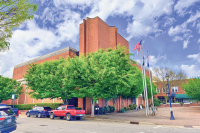Firing range sparks outcry in budget meeting
 It was suppose to be Canton’s wrap-up budget meeting. But community members showed up to voice concerns about a specific item tucked within that budget: a proposed firing range in the Gibsontown neighborhood.
It was suppose to be Canton’s wrap-up budget meeting. But community members showed up to voice concerns about a specific item tucked within that budget: a proposed firing range in the Gibsontown neighborhood.
“Our presence here clearly states that we’re probably not for this,” said Wanda Walker.
Walker represented a group from Gibsontown, a predominantly African-American community within the Canton town limits. She stood up to speak to the town board as the group, numbering almost two dozen, sat in the audience in solidarity.
“Our primary concern is the safety, noise concerns and traffic patterns with this range,” Walker said. “Please consider our concerns, these people live a few steps from this proposed range.”
For the past 30 years, Canton police officers have used a firing range located on property owned by Evergreen Packaging for yearly qualification training. The need for a new range arose when the paper mill decided to build a new landfill cell on the current location.
The proposed range would be built on the town’s old landfill on Dutch Cove Road, a busy thoroughfare for the Gibsontown community. The range would consist of five lanes, allowing five officers to train simultaneously.
Related Items
Although the Canton board looked at the new proposed property as the most logical place for the range, based on possible modern uses for the old landfill, residents of Gibsontown viewed it as another community problem again pushed onto their neighborhood — an area already buffered by two landfills.
“How come we are the last people to know about what’s going on in our neighborhood?,” said Gibsontown resident Ken Davis. “There are families that have been there for 100 years, and now you want to throw a firing range in our front yard?”
Finding a solution
In response, the board pointed out that the $3,500 firing range item on the budget was only an earmark for a proposed site, with no official plans set in stone. The earmark would be used to conduct a feasibility study, apply for permits and materials for construction of a backdrop. The board continually stressed it was just money put aside for future options, and that no site would be built near Gibsontown until all the proper steps and public input hearings were completed.
“[Firing ranges] can be loud, they can be dangerous and there are lots of negative connotations,” said Town Manager Seth Hendler-Voss. “But we will have to find a long-term solution to find a place for our officers to qualify — that is the end goal and we are exploring all options.”
Hendler-Voss later explained that Canton officers currently use ranges in nearby areas for qualification training. Using outside ranges costs the town $250 annually. The first phase of the proposed range would run $3,500, with a second phase to be completed later for an additional $3,000.
Despite reassurances that the town was only in an exploratory phase, and not locked into any plans on the proposed range, Gibsontown residents remained skeptical. Hendler-Voss then referred to the property as “undesirable,” in that it currently has no other use for the town. But, those words caused an uproar with Gibsontown residents in the audience, who angrily asked the board if that meant their neighborhood was also looked upon as “undesirable.”
“The voice of this community is going to heard. We’re not going to sit back and take it anymore,” Gibsontown resident Ken Smith said. “This ain’t the 1960s, you can’t do this to us anymore. You bring this [firing range] to a white neighborhood and see what will happen — they won’t let it happen.”
Amid protest from the audience, which included personal stories from elderly people and a military veteran suffering from post-traumatic stress disorder, the board continued to stand its ground. Board members maintained that the firing range was not a race issue, but rather a town issue that needed to be addressed.
Once the meeting room calmed down, Alderman Zeb Smathers stood up to speak.
“We will not do anything until we address the concerns from the Gibsontown community and other stakeholders,” Smathers assured the group.
Mayor Mike Ray noted that he appreciated residents bringing their concerns to the board.
“It’s better to have this before rather than after and we thank you for your comments and concerns,” Ray said.
A call for action
A few days after Gibsontown residents confronted officials about the proposed firing range, a press conference was scheduled by the town to address the issue. The press conference was announced around 1 p.m. on June 30, then scuttled an hour later when it was scheduled to commence.
“It was called in anticipation of a rally, which we were not even sure was going to be taking place,” said Hendler-Voss.
The town manager explained that WLOS television station had called earlier and informed officials that the Gibsontown community was planning to hold a rally that afternoon pertaining to the proposed firing range. The press conference was scheduled in response to the rally — “we’re just trying to be responsive” — but then cancelled when officials figured the “rally” to be a meeting about the planned community center at the old Reynolds High School within Gibsontown.
There did not appear to be any new information planned for presentation at the press conference. The town’s position — that the firing range conversation is in its “infancy” — remained the same.
“We are considering all options,” Hendler-Voss said, “And we take very seriously the feelings of our taxpayers and other community members.”
Rebuilding a community
At the Reynolds High School, however, a rally did transpire.
William McDowell and his wife, legendary Motown/R&B singer Gladys Knight, were present to kickoff renovations of the abandoned school. The couple recently bought the structure and are currently in the beginning stages of transforming it into a community center that will include a library, media center, movie theater and music studio.
McDowell attended the all-black school until third grade in 1965, when segregation in the district ended and all of the town consolidated into what is now Pisgah High School.
And though it was a time of celebration for Gibsontown, the recent firing range controversy bubbled to the surface of event. Mayor Mike Ray and local media were there for the discussion.
“We tried to get the ball rolling, the NAACP was there and they were behind us, and they could, from their own observations, see the inequality in the [firing range] issue,” said Gibsontown resident Ken Davis, who was at the budget meeting. “But every time we tried to bring it up the mayor didn’t really want to talk about it — everyone was pushing their agenda and the firing range kept being overshadowed.”
Contacted after the meeting, Haywood County NAACP President Chuck Dickson said the group was not taking an official position on the issue.
Davis said the next course of action for the fight against the firing range would be to get the Environmental Protection Agency involved, suggesting studies needed to be conducted concerning the possible hazardous nature of the landfill property and what effects the range could have.
When asked by WLOS if there was any indication of racism in the issue of the range, Ray once again reiterated that wasn’t the case.
“None whatsoever,” he said. “This was [just] property the town owned.”









